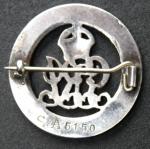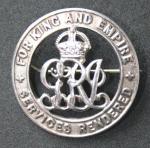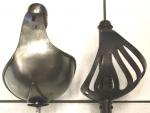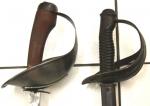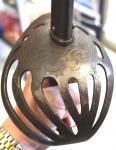-
Posts
13,225 -
Joined
-
Last visited
-
Days Won
22
Content Type
Profiles
Forums
Blogs
Gallery
Events
Store
Everything posted by Mervyn Mitton
-
Hi - David. Yes - there were two types . The large fighting Iwisas - Knobkerries to us, were of a standard pattern. I suspect that Durban Municipality ordered them from one source - but, unless one goes through the records I don't suppose we will know for sure. There is a second pattern - much smaller - more the size of a truncheon, however , it has a knob end. Both were carried stuck in the belt. The African Police did not patrol on their own - but two usually accompanied a European officer. They had spears - made by Vickers in the UK - for serious rioting - otherwise it was just the Iwisa. This is a terrible weapon and always remember - young Zulus are trained in the art of stick fighting from about 4 years of age . They were not allowed to arrest or deal with Europeans - although could be called onto assist the white officer. They also carried handcuffs. I've just noticed that you are asking for the SAP and not just Durban. I think the same basic rules applied. I remember watching a 100 Company of African SAP charge a crowd in the 1950's - they were carrying the spears. What a wonderful weapon for close combat - they should have had them in London last week ? I will get a photo of the small Iwisa and make a post.
-

Sudanese or, Eritrean dagger
Mervyn Mitton replied to Mervyn Mitton's topic in Swords & Edged Weapons
The blades on most Arab daggers are up-turned at the end - this is for a sharp upward thrust that goes under the ribcage and can penetrate to the heart. The metal for the blade is nearly always from old car and jeep springs - which blunts very easily and goes rusty - as here ! -
We often see these small Arab style daggers in South Africa - the troops in WW2 bought them whilst in Ethiopia,Sudan and in Eritrea. The skin is always camel and usually the handle is bone or, wood. This one is quite attractive since it has brass and turned local stones. They would carry it either tied around the arm - with the handle downwards - or, as a belt dagger. Arm daggers usually have a longer handle (as shown in the post last Aug) and a different point. Just a quick post to keep the momentum going............
-
This is the second truncheon - it was brought in this morning from Rhodesia - but, it is of course of British origin. Many early settlers took old truncheons with them as protective items - unfortunately, they were no match for spears ! The markings show that it is a Victorian Special Constable's truncheon - and it has S 2 on the body. The Crown is Queen Victoria's and the initials VR, standing for Victoria Regina. I would date this to about 1850.
-
The first of these is an Irish 'bog oak' truncheon. We have had discussions and photos of these in the past - particularly with regard to their use. I am almost certain that it was an attempt to introduce local policing - perhaps along the lines of the old British Parish Constables. The Royal Irish Constabularly were a para-military Force - and many of the public saw them as an 'enemy'. I have never found the Acts which would have allowed the setting-up of localised Constables - something for someone to research. From the many that I have in my collection - or, have seen elsewhere, this is the first to have a town name. Actually, the City of Belfast and it is dated 1901. This makes them a little later for use then I thought. Nicely carved with clovers - and since Bog Oak is fallen oaks that have been for years in the swamps (or, Bogs) - it is not only darkened, but very hard to cut - and these decorations are all by hand !
-
Nick - the shako was used in Cheshire and I think in some other areas. I remember Ian showing a list some time ago. The Met. have black braid on peaks for Inspector's and Chief Inspector's - however, I noticed on a picture of Robin Lumsden's - when he was a Ch.Insp. that his Scottish Force used silver.
-
Jean-Paul - the citations shown here , are a wonderful testimonial to how people respond to serious situations. These are Australian awards - but could be for any Country. The old expression that a man will face-up to a challenge - is so true ! The most unlikely people - performing mind boggling acts of valour - often without thought to their own safety. Find 10 minutes to read some of these brief, terse accounts for the Awards - you will be humbled .
-
There are a number of senior officers of Chief Constable Rank who are not in fact running a County Force. One of them is the Commandant of the Bramshill Police College. As the Daily Mail points out they wear the insignia and uniform of the Force they were attached to. This man is obviously unstable and has totally 'shot himself in the foot'. I suppose he will now spend the rest of his life claiming it was all a conspiracy - whereas, he should in fact be charged with impersonating a police officer - a serious offence.
-
During the 1st World War it was quite common for ignorant civilians to abuse and ridicule any man in public but, not in uniform. Military authorities quickly realised that this could cause a man discharged with wounds - or, perhaps re-cuperating from wounds and in civilian dress, great distress. The badge selected was in silver - had the Royal cypher - and was numbered on the reverse to prevent mis-use. Most British Countries had these badges and during the course of the two World Wars, there were different patterns and styles. I am sure many members will have examples and I hope that we can extend this thread. Strictly speaking they do not come under our heading of Medals - however, many recipients looked on them as an award - particularly, since the medals were not issued until much later. The one I am showing here is 1st World War and is South African in origin.
-

Cuffs of the dragoons.
Mervyn Mitton replied to Vitalio's topic in Great Britain: Militaria: Badges, Uniforms & Equipment
Vitalio - if you are having problems you can ask for help on the section at the bottom of the forum. I will be pleased to post these for you - check my home page for my email address -
Odulf - the French were proBoer and quite anti British in the Boer War. I have a collection of about 50 of the Petite Parisien from this period - it was their colour supplement. They picked out stories and had them illustrated in lurid style and with little regard for accuracy. They delighted in showing the British as aggressors and the drawings always showed them being beaten or, behaving badly. I have never heard of this 'execution' - and I cannot for a moment, think of a British Captain having his decks splattered with blood. I will be interested to hear if Brett Hendy or, Will Endley have heard of this 'incident' - or, indeed from any member ?
-

DUTCH CAVALRY SWORD - POST 1908
Mervyn Mitton replied to Mervyn Mitton's topic in Swords & Edged Weapons
Thankyou Odin - I thought I recognised the name - however, it is always good to be sure. That was a very interesting link and many of the guards are similar with the cutouts - I could not see this pattern with the thin , long scabbard ? Perhaps it was made for use elsewhere ? -

DUTCH CAVALRY SWORD - POST 1908
Mervyn Mitton replied to Mervyn Mitton's topic in Swords & Edged Weapons
A 'head-on' for the guards. 1908 on left. Note, British has slot for sword knot on top - the other one at lower left. -

DUTCH CAVALRY SWORD - POST 1908
Mervyn Mitton replied to Mervyn Mitton's topic in Swords & Edged Weapons
-

DUTCH CAVALRY SWORD - POST 1908
Mervyn Mitton replied to Mervyn Mitton's topic in Swords & Edged Weapons
-

DUTCH CAVALRY SWORD - POST 1908
Mervyn Mitton replied to Mervyn Mitton's topic in Swords & Edged Weapons
-

DUTCH CAVALRY SWORD - POST 1908
Mervyn Mitton replied to Mervyn Mitton's topic in Swords & Edged Weapons
-

DUTCH CAVALRY SWORD - POST 1908
Mervyn Mitton replied to Mervyn Mitton's topic in Swords & Edged Weapons
-

DUTCH CAVALRY SWORD - POST 1908
Mervyn Mitton replied to Mervyn Mitton's topic in Swords & Edged Weapons










